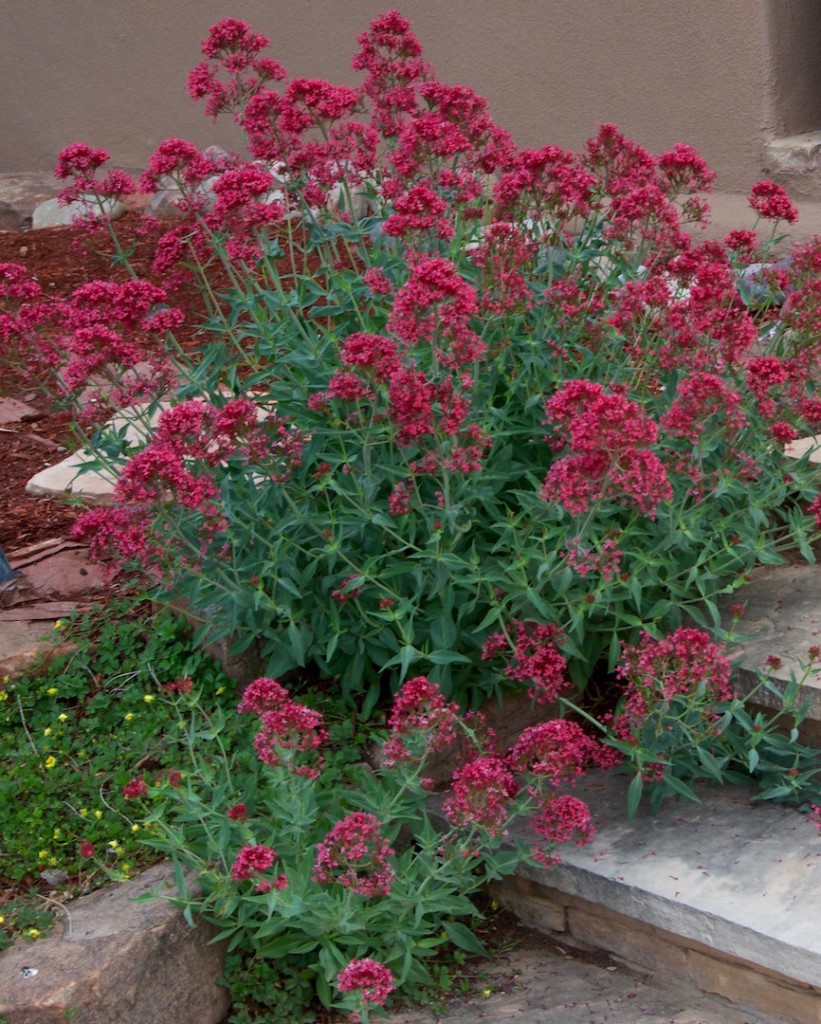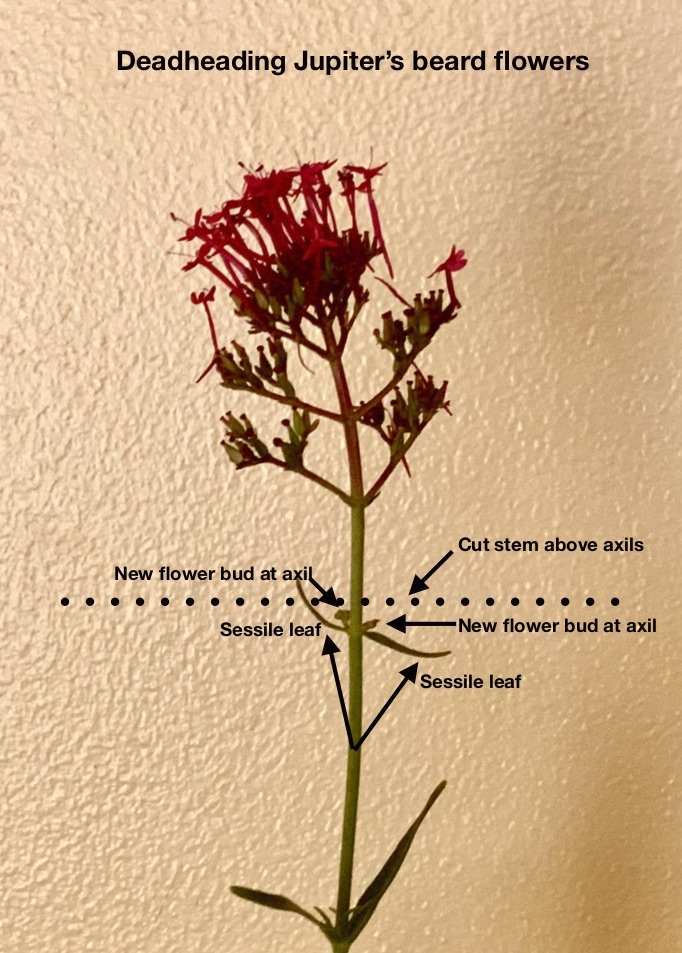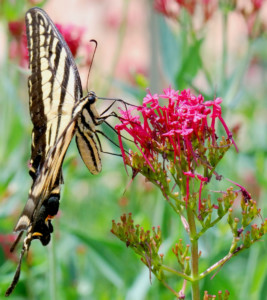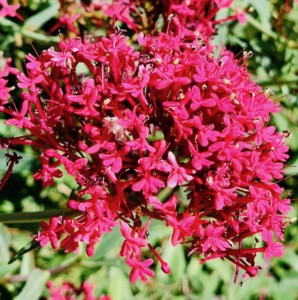Scientific name: Centranthus ruber (pronounced sen-TRAN-thus ROO-ber)
Common names: Jupiter’s beard, red valerian, keys-to-heaven, kiss-me-quick
Family name: Caprifoliaceae (honeysuckle) (pronounced cap-ree-foh-lee-AY-see-ee)

Jupiter’s Beard in full bloom. Photo by Janice Tucker.
Article by Janice Tucker.
Photos by: Janice Tucker and Sonny Tucker
Wouldn’t it be great if there was a perennial with showy flowers that bloomed from spring until frost? Wouldn’t it be even better if this plant was easy to care for, was drought tolerant and behaved well toward neighboring flowers and shrubs? Is there such a plant and if so can it thrive in Santa Fe? Well, yes there is.
Say how-do-you-do to the Centranthus ruber, commonly known in our area as Jupiter’s beard or red valerian.
Native to the Mediterranean region, the Centranthus species escaped cultivation to spread into many parts of the world including a large swath of North America covering USDA Plant Zones 5 to 8. Introduced plants sometimes become major pests when they prove to be too aggressive. That is the case in South Africa where the Centranthus has been declared so invasive that it is totally banned in that country. And it does reseed prolifically. But so far in the contiguous United States this Old World plant may be assertive but not so aggressive to the point of alarming the agencies that keep a sharp eye out for invasive species. In Santa Fe’s plant zone 6b, Jupiter’s beard is the rare perennial that continually blooms from mid-to- late May into mid-to-late October or until the chilly fingers of Jack Frost put it to bed for the winter. The woody base and hardy roots keep it healthy in cold weather enabling it to reappear in the spring.
Rather than a featured garden showstopper, the Jupiter’s beard is usually designated as an underplanting for taller plants or part of a flowerbed to mingle with other ornamentals. The attractive, symmetrical growth habit reaches a height ranging from 1.5 to 3 feet and a spread of 30 inches. Reddish floral bouquets crown hollow, smooth stems lined with opposite, oval or lanceolate, gray-green leaves. Basal leaves are attached to the stem by petioles while the upper leaves clasp directly onto the stem (sessile). Multiple, tiny, bisexual flowers, each with 5 petals and one stamen, form tight clusters (cyme) that bloom at the terminal ends of the stems and at the axils of the sessile leaves. Flowers of the Centranthus ruber and its cultivars vary in hues of rose-red to light pink. The white-flowering cultivar, Centranthus ruber ‘Albus’, is less common. Some sources describe the flowers as rendering an unpleasant odor while others claim fragrance as a desirable attribute. In this case, perhaps the scent depends on the nose of the sniffer! The flowers are a pollinators’ paradise. Hummingbirds, butterflies, moths and bees vie for their abundant supply of nectar.

Jupiter’s beard planted with lavender. Photo by Janice Tucker.
Photos above from left to right: 1) Hummingbird on Jupiter’s beard by Sonny Tucker. 2) Sphinx moth on Jupiter’s beard by Janice Tucker. 3) Painted lady butterfly on Jupiter’s beard by Janice Tucker.
Jupiter’s beard likes full sun or partial shade. It actually prefers poor soil that drains well. But regular garden soil is fine as long as it is not too rich in nutrients. Very little, if any, supplemental water is required, making it a colorful choice for xeric gardens. It will tolerate extra water in a flowerbed shared by other plants but does not like soggy soil. It does not compete well in an area with aggressive plants such as Russian sage or some ground covers, and could die back as a result.

Jupiter’s beard in fire pit. Photo by Janice Tucker.
Propagation can be attained by basal cuttings in the spring or plant division in fall or spring, but it naturally spreads by seed. The spent flowers morph into seed-filled tufts. These tufts are carried by the wind, and no telling where a seed will alight and germinate. It might turn out to be a delightful surprise. For example, a Jupiter’s beard decided that an unused fire pit would be a perfect home. This pit was not filled with soil, there was no supplemental water source and was, quite frankly, a bit of an aggravation. No matter. A seed germinated, the plant emerged and there is now a lovely, blooming Jupiter’s beard in that fire pit, proving that a silk purse really can be made from a sow’s ear! (See accompanying photograph). And it just might make the decision on its own to fill a vacant garden spot, thus relieving the gardener of the burden in deciding what plant will flourish in that space. But if it sprouts where not welcome, pull it up.

Demo deadheading Jupiter beard’s flowers. By Janice Tucker.
Maintenance is usually limited to deadheading spent flowers and in Santa Fe’s dry climate, pruning it back to about halfway in early spring. For wetter environments, cut it back to overwinter. Neither of these garden chores is mandatory but doing them makes for a more groomed appearance. Deadheading will also discourage too much reseeding but you may want to leave a few spent flowers to allow for a little bit of propagation. Deadheading is blessedly easy. Hold a spent bloom between your fingers. Down the stem to the next leaves there will most likely be new flowers or new flower buds at the leaves’ axils on each side of the stem. Cut the stem just a bit above the flower buds.(See accompanying photo.) When the new flowers fade, it’s time to deadhead again. The end of the blooming cycle is evident when there are no longer new flowers at the axils.
Swedish botanist, Carl Linnaeus (1707-1778), named the genus, Centranthus, which means, “a flower with a spur-like base”. It is a compound word from the Greek , kentron, which means “spur”, and anthos for “flower”. Take a close look at one of those tiny flowers. Behold! There is a spur that extends out from its base. A good image of the flower spurs can be seen in the accompanying photograph of the Yellow Swallowtail butterfly feeding on the Jupiter’s beard. The species is from the Latin, ruber, “red”, which refers to the flower color.

Yellow swallowtail on Jupiters beard showing flower spurs. Photo by Janice Tucker.
Red valerian is one of the common names for the Centranthus ruber. Valerian is the common name for Valeriana officinalis a pink-flowered species in the Valeriana genus. At one time both the Centranthus and Valeriana genera were in the Valerianaceae family but are now classified in the Caprifoliaceae (honeysuckle) family. The two genera do have some similarities. However, the medicinal properties of the Valeriana officinalis are well noted and documented. Centranthus ruber does not share those traits. Thus, the common name of red valerian is a bit misleading.
Jupiter’s beard is the common name most frequently used in the Santa Fe area. Since research failed to find anything that explains the reason for this common name, personal speculation and imagination ensued at this point. In Roman mythology Jupiter is the king of the gods and also known as the king of sky and thunder. He is the equivalent to the Greek god, Zeus or the Norse god, Thor. Many images depict Jupiter sporting a tightly curled beard. Now take a look at the flowers of the Jupiter’s beard. Can you stretch your imagination to see those tight, reddish flower clusters as resembling the beard of the Roman god of the kings? If there’s another explanation, it would be good to know. There must be intriguing reasons for the names keys-to-heaven and kiss-me-quick but the inspiration behind those vernaculars remains elusive.

Close up of Jupiter’s beard. Photo by Janice Tucker.
Writer’s disclosure: Jupiter’s beard was among the plants in the garden of our house when we purchased it 22 years ago. It was totally new to me. It has patiently tolerated the fits and starts of my learning curve surrounding the challenges of gardening here. Over the years I have come to admire and respect this reliable, non-native perennial and it has reciprocated in its own special way. It has surrendered its flowery stems to serve as attractive fillers in cut flower arrangements. It popped up in an area that had not yet been planted and proved to be the perfect choice for that spot. I swear it heard my grumblings about that fire pit mentioned earlier, which we did not build, and did not want. But the seed of a Jupiter’s beard made it into an attractive planter. Plus, it faithfully blooms its heart out every year. How can I not love this plant? It is my wish that if or when other gardeners give Jupiter’s beard a place in their gardens they will have the same satisfying experience with it that I have enjoyed.
Thanks to Helen Woody and Jeanne Gozigian for proofreading this article.
Sources consulted:
“Centranthus ruber-Plant Finder”. Missouri Botanical Garden. Web. 19 Oct. 2019. Retrieved from: http://www.missouribotanicalgarden.org/PlantFinder/PlantFinderDetails.aspx?kempercode=b950
“Centranthus ruber”. Wikipedia. Web. 07 Nov. 2019. 09 Nov 2019 Retrieved from: https://en.wikipedia.org/wiki/Centranthus_ruber.
“Greek and Roman Gods”. Greek Gods and Goddesses. Web. 2019. 10 Nov. 2019. Retrieved from: https://greekgodsandgoddesses.net/greek-vs-roman-gods/.
Phillips, Judith. New Mexico Gardener’s Guide. Franklin, Tennessee; Cool Springs Press. 1998. Print.
“Red Valerian (Centranthus)”. High Country Gardens. Web. 2019. 01 Nov. 2019. Retrieved from: https://www.highcountrygardens.com/perennial-plants/centranthus-jupiters-beard/centranthus-ruber-coccineus.
“Roman Mythology”. Wikipedia. Web. 03 Nov. 2019. 17 Nov. 2019. Retrieved from: https://en.wikipedia.org/wiki/Roman_mythology.
“Santa Fe’s designation in USDA’s 2012 Plant Hardiness Zone”. Santa Fe Botanical Garden. Web. 2019. 31 Oct. 2019. Retrieved from: https://visitsfbg.org/2012-plant-hardiness-zone-map/.
Stearn, William T. Stearn’s Dictionary of Plant Names for Gardeners. London, England: Cassell Wellington House, Orion Publishing, Reprinted with new Preface. 2004. Print.
“Thor”. Wikipedia. Web. 03 Nov. 2019. 09 Nov. 2019. Retrieved from: https://en.wikipedia.org/wiki/Thor.
“USDA Zone Map”. High Country Gardens. Web. 2019. 08 Nov. 2019 Retrieved from: https://www.highcountrygardens.com/zone-map-usda.
“Valerian (herb)”. Wikipedia. Web. 10 Oct. 2019. 08 Nov. 2019. Retrieved from: https://en.wikipedia.org/wiki/Valerian_(herb).
“Valerian, red.” Cornell University Growing Guide. Web. 2006. 08 Nov. 2019. Retrieved from: http://www.gardening.cornell.edu/homegardening/scene2d02.html.
“Valeriana”. USDA, Agricultural Research Service, National Plant Germplasm System. 2019. Germplasm Resources Information Network (GRIN-Taxonomy). National Germplasm Resources Laboratory, Beltsville, Maryland.
URL: https://npgsweb.ars-grin.gov/gringlobal/taxonomydetail.aspx?id=400139 . Accessed 14 November 2019.
“Valeriana”. Wikipedia. Web. 19 Sept. 2019. 05 Nov. 2019. Retrieved from: https://en.wikipedia.org/wiki/Valeriana.


